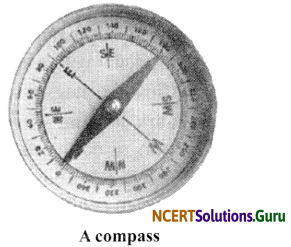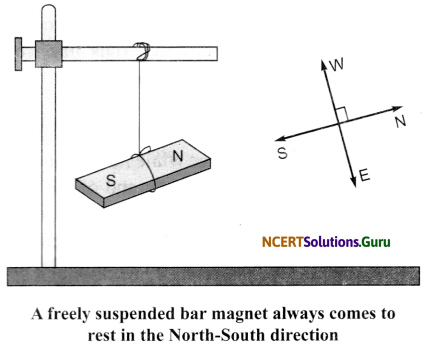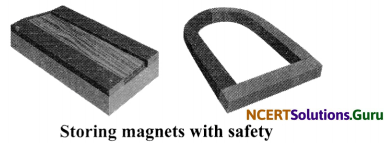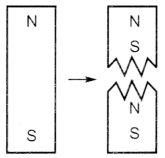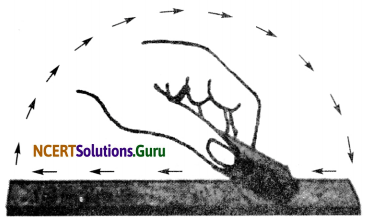NCERT Solutions for Class 6 Science Chapter 16 Garbage In, Garbage Out
These NCERT Solutions for Class 6 Science Chapter 16 Garbage In, Garbage Out Questions and Answers are prepared by our highly skilled subject experts to help students while preparing for their exams.
Garbage In, Garbage Out NCERT Solutions for Class 6 Science Chapter 16
Class 6 Science Chapter 16 Garbage In, Garbage Out Textbook Exercise Questions and Answers
Question 1.
a.Which kind of garbage is not converted into compost by the red worms?
b. Have you seen any other organism besides redworms, in your pit? If yes, try to find out their names. Draw pictures of these.
Answer:
a. The garbage which consists of cloth, broken glass, aluminium wrappers, polythene bags, nails, broken toys and old shoes cannot be converted into compost by red worms,
b. Yes, a pit might contain other soil microbes such as bacteria, other species of earthworms such as brandling worm and red wiggler worm.

Question 2.
Discuss:
a. Is garbage disposal the responsibility only of the government?
b. Is it possible to reduce the problems relating to disposal of garbage?
Answer:
a. Proper disposal of garbage should be a concern of every citizen, and not just of the government. Each and every individual must reduce activities that pollute the environment. A lot of waste is generated from homes, offices, schools, hospitals, etc. It includes food waste, paper, plastic, glass, metal, etc. Therefore, it is required that every individual must reduce the production of wastes and must help in the proper disposal of these wastes.
b. Yes, it is possible. Here are some steps that can be observed by every individual to reduce the problem of garbage disposal:
- Avoid using plastic bags. Encourage shopkeepers to use paper bags or always carry a cloth or jute bag while shopping
- Save paper. Use both sides of paper to write.
- Use separate bins for recyclable and non-recyclable waste.
- Kitchen waste that includes fruit and vegetable peels, waste food, tea leaves, etc., can be used to make manure.
- Encourage your family, friends, and others to follow proper disposal practices.
Question 3.
a. What do you do with the leftover food at home?
b. If you and your friends are given the choice of eating in a plastic plate or a banana leaf platter at a party, which one would you prefer and why?
Answer:
a. Leftover food at home along with other kitchen waste like vegetable peel, paper are dumped into compost pit to convert them into manure. Later on manure is used to grow plants.
b. We will select banana leaf platter because it can be easily converted into manure by composting. Plastic plate can be recycled but in this process it gives out harmful gases which pollute the environment. Plastic items cannot be converted into manure by composting.
![]()
Question 4.
a. Collect pieces of different kinds of paper. Find out which of these can be recycled.
b. With the help of a lens, look at the pieces of paper you collected for the above question. Do you see any difference in the material of recycled paper and a new sheet of paper?
Answer:
a. Most of the papers available in market are recyclable, i.e., newspapers, notebooks, magazines, paper sheets, envelopes, etc.
b. The difference between new sheet and recycled paper is that the surface of new sheet is smooth whereas that of recycled paper is rough.
Question 5.
a. Collect different kinds of packaging material. What was the purpose for which each one was used? Discuss in groups.
b. Give an example in which packaging could have been reduced?
c. Write a story on how packaging increases the amount of garbage.
Answer:
a. Packaging materials like thermocol, foam sheets, paper cuttings, cardboard and jute are used to protect the articles. Cardboard boxes, plastic containers and tin containers are used to facilitate transportation of the packed materials.
b. Packaging of toys, clothes, shoes, chocolates can be reduced.
c. We use packaging materials to protect the articles and also to make package good-looking. For example, to give a gift on birthday, the gift is packed and wrapped in a shiny paper or plastic-coated paper. After use the packing material is thrown in dustbin. Similarly, plastic bags, cans, aluminium foils, plastic or aluminium cans and other packaging materials are used and thrown out after use. Many things such as ghee, refined oil, soaps, detergents and most of eatable goods are sold in small packets. All of this increases the garbage due to packing.
Question 6.
Do you think it is better to use compost instead of chemical fertilisers? Why?
Answer:
Yes, compost is better than chemical fertilisers because:
- Compost is eco-friendly and does not pollute the environment. Fertility and texture of the soil is maintained while using compost.
- The natural composition of the soil is affected while using fertilizers and some of them are even toxic in nature at higher quantities.
- Compost is easy to make and cheap whereas fertilisers are costly and also harmful.
- Compost is easier to prepare.
NCERT Extended Learning Activities And Projects
Question 1.
Collect old and discarded objects and materials like glass bottles, plastic bottles, coconut husk, wool, bedsheets, greeting cards and any other thing.
Can you make something useful out of these, instead of throwing them? Try.
Hint.
Do it yourself.
Question 2.
Prepare a detailed project report on compost making activity you did in school.
Hint.
Do it yourself.
![]()
Class 6 Science Chapter 16 Garbage In, Garbage Out Additional Important Questions and Answers
Very Short Answer Type Questions
Question 1.
What is vermicomposting?
Answer:
Vermicomposting is a method of composting where compost is made from biodegradable waste with the help of redworms.
Question 2.
What is redworm?
Answer:
It is a type of earthworm used for composting.
Question 3.
Which organisms other than earthworm is involved in composting?
Answer:
Microorganisms such as bacteria, fungi etc., are involved in composting.
Question 4.
Suggest some packaging material which can be recycled or reused.
Answer:
Glass bottles, recycling polythene and jute bags.
Question 5.
List a few things we use that are made of plastics?
Answer:
Toys, shoes, bags, pens, combs, toothbrushes, buckets, bottles, water pipes, etc.
Question 6.
What are the uses of green-coloured bins?
Answer:
The green bins are for collecting kitchen and other plant or animal wastes.
![]()
Question 7.
When is rotting of garbage said to be completed?
Answer:
A black colour and no foul smell indicate that rotting of garbage is complete.
Question 8.
For what purpose are blue-coloured bins used?
Answer:
The blue bins are used for collecting waste materials that can be used again, such as plastics, metals and glass.
Question 9.
What is composting?
Answer:
The rotting and conversion of some materials into manure is called ‘composting’.
Question 10.
What is a landfill?
Answer:
Landfill is an area where the garbage collected from a city or town is dumped. The area is later converted into a park.
Question 11.
What kind of waste materials rot completely when buried in the soil?
Answer:
Waste materials such as kitchen, plants and animal waste rot completely when buried in the soil.
Question 12.
What does kitchen waste mainly consist of?
Answer:
Kitchen waste mainly consists of fruits and vegetable peels, eggshells, waste food and tea leaves.
![]()
Question 13.
Which items should not be included for making compost?
Answer:
Pieces of cloth, polythene bags, broken glass, aluminium wrappers, nails, old shoes, broken toys, etc.
Short Answer Type Questions
Question 1.
What should we do with the left-over food at home?
Answer:
We should do the following to the left-over food:
- Preserve food properly for reuse.
- Use it in preparation of some other food item and consume it.
Question 2.
Polythene bags should not be used for garbage disposal. Why?
Answer:
Plastics thrown carelessly get into drains and sewages which often results in blockage and causes water-logging. So polythene bags should not be used for garbage disposal.
Question 3.
What are the uses of plastics?
Answer:
Cleaning solution and soap containers, food and drink storage, shopping bags, freezer bags, pipes, insulation, bottle caps, vehicle fuel tanks, protective helmets, etc. are all made from plastics.
Question 4.
Why do polythene bags create a big problem in garbage disposal?
Answer:
Some kind of plastics can be recycled, but not all of them. Polythene bags and some plastics do not rot. Thus, polythene bags create a big problem in garbage disposal.
![]()
Question 5.
Why plastic should not be burnt?
Answer:
All kind of plastics give out harmful gases, upon heating or burning. These gases may cause many health problems, including cancer in humans. Thus, plastic should not be burnt.
Question 6.
Why is burning of husk, dried leaves and part of crop plants considered as bad practice? What could be a better alternative?
Answer:
Burning of these produces smoke and gases that are harmful to our health. We should try to stop such practices. These wastes could be converted into useful compost.
Question 7.
Why should we not use wastes that may contain salt, pickles, oil, vinegar, meat and milk preparations as food for redworms?
Answer:
We should not use wastes that may contain salt, pickles, oil. vinegar, meat and milk preparations as food for redworms because if you put these things in the pit, disease-causing small organisms start growing in the pit.
Question 8.
Suggest some handicrafts which can be prepared using waste materials.
Answer:
Files from old charts, greeting cards decorated with flowers made from pencil shavings, mats from old clothes, baskets from used old polythene bags and diary from invitation cards are some of the items which can be prepared using waste materials.
![]()
Question 9.
Rag pickers always suffer from diseases. Give reason.
Answer:
- Garbage dumps have flies, cockroaches and mosquitoes, which later turn into breeding grounds for micro-organisms that may cause several diseases.
- While picking through waste, the rag pickers put themselves at a great risk and are always prone to disease as the waste that they search through can be infected.
Question 10.
What are the effects of throwing garbage in open place?
Answer:
Effects of throwing garbage in open place are as follows:
- Garbage will start decaying and as a result of this, bad smell spreads in the nearby areas.
- It will become a breeding ground for mosquitoes and flies.
- It causes air and land pollution and thus causes many health problems.
- It destroys the aesthetic look of a place.
Question 11.
What is the role of a junk dealer? Do you think junk dealers help in waste management?
Answer:
The role of a junk dealer is collection of wastes from various sources. Yes, junk dealers help in waste management by segregating the wastes as recyclable and non-recyclable materials.
Question 12.
State one difference between composting and vermicomposting.
Answer:
Composting is a method in which biodegradable wastes such as vegetable peels, waste food, leaves, etc., can be recycled and converted into manure by burying them in compost pits. The method of making compost from kitchen wastes (or kitchen garbage) by using red worms is called vermicomposting. The compost made by using red worms is called vermicompost.
Long Answer Type Questions
Question 1.
What are the merits and demerits of using plastic?
Answer:
Merits of plastic:
- It is durable.
- It is low at cost.
- It is water resistant.
- It is lightweight.
- It is unbreakable.
Demerits of plastic:
- It gives out harmful gases upon heating or burning.
- It is non-biodegradable.
- If it is thrown carelessly on roads or other places, it gets into drains and sewer system and chokes them.
Question 2.
What can we do to minimise overuse of plastics and deal with garbage?
Answer:
We can do the following to minimise overuse of plastics and deal with garbage:
- We can make a minimum use of plastic bags. We can reuse the bags whenever it is possible to do so.
- We can insist shopkeepers to use paper bags. We can carry a cloth or a jute bag when we go out for shopping.
- We should not use plastic bags to store eatables.
- We should not throw plastic bags here and there, after use.
- We should never bum plastic bags and other plastic items.
- We should do not put garbage in plastic bags and throw it away.
- We should use vermicomposting at home and deal with our kitchen waste usefully.
- We can recycle paper.
- We should use both sides of the paper to write. We can use a slate for rough work. We can use blank sheets of paper left in our notebooks for rough work.
![]()
Question 3.
How can we make handmade paper?
Answer:
Steps to make handmade paper:
- Tear the paper into small pieces. Put them in a tub or a bucket and pour water in it.
- Let the pieces of paper remain submerged in water for a day. Make a thick paste of paper by pounding it.
- Now, spread the wet paste on the wire mesh fixed to the frame. Pat it gently to make the thickness of layer of the paste as uniform as possible.
- Wait till water drains off. Now, carefully remove the layer of paste from the frame, spread it on a sheet of newspaper in the sun.
- Keep the corners of the newspaper sheet pressed by putting some weights so that these do not curl up.
- Add food colour, pieces of dry leaves or flower petals or pieces of coloured paper in the paste before spreading it so as to get a recycled paper with beautiful patterns on it.
Question 4.
Distinguish between bio-degradable and non-biodegradable wastes.
Answer:
Biodegradable wastes:
- The substances which get degraded to simpler and harmless substances over a period of time are known as biodegradable.
- They are not harmful to animals and plants, e.g., cow dung, leaves, paper, etc.
Non-biodegradable wastes:
- The substances which do not get degraded to simpler and harmless substances over a period of time are known as non-biodegradable.
- They are harmful to plants and animals, e.g., DDT, plastic, polythene, etc.
Question 5.
What suggestions you will give to the members of your locality to solve the problem of waste materials?
Answer:
We will suggest the members of my locality to use biodegradable waste in preparing compost. To take people in confidence, we should make efforts to show the path for preparing compost:
- You should select a comer of your locality.
- Dig a pit at open place and ask all the residents to throw their kitchen waste in this pit. Cover the biodegradable waste in the pit with layers of soil.
- Cover the pit with the mixture of soil and dung.
- After 5-6 weeks, open the pit and show it to the residents of your colony. Also explain that their disposed off materials have been converted into compost manure.
- You can convince RWA (Resident Welfare Association) to use this manure for colony parks and also in plant pots kept in individual houses for beautification.
![]()
Question 6.
List the steps for preparing vermicompost.
Answer:
- Dig a pit about 30 cm deep or select a wooden box.
- Spread a net or chicken mesh at the bottom of pit or box. You can also spread 1 to 2 cm thick layer of sand.
- Spread some vegetable wastes including peels of fruits over the sand layer. You can use green leaves, husk or pieces of newspaper, dried stalks of plants and dried animal dung.
- Sprinkle some water to make the layer wet. Do not use excess of water. Press layer of leaves or waste so that it has sufficient air and moisture.
- Now, buy some redworms and put them in the pit.
- Cover them loosely with a gummy bag or an old sheet of cloth or a layer of grass.
- Redworms need food. So you can provide them as food- vegetable and fruit peels, coffee and tea remains and weeds from the field or garden. Bury this food about 2-3 cm inside the pit.
- Do not put salt, pickles, oil, vinegar, meat and milk preparations. This may cause growth of disease-causing organisms. Redworms do not survive in very hot or very cold surroundings.
- After 3-4 weeks, put some w^aste food in one corner of the pit. Most of the worms will shift towards newly added food.
- Remove the compost from the vacated part and dry it in the sun for a few hours. The vermicompost becomes ready for use.
Picture-Based Questions
Question 1.
Observe the given figures and answer the following questions.
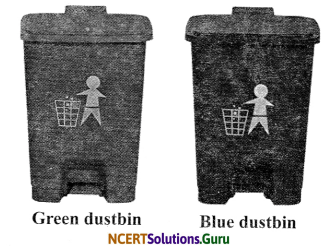
a. Which of the above bins is used to dispose biodegradable waste?
b. Which of the above bins is used to dispose non-biodegradable waste?
Answer:
a. Green dustbin
b. Blue dustbin
![]()
Question 2.
a. Identify the organisms shown below.

b. What are these organisms used for?
Answer:
a. Redworms (earthworms),
b. These are used for making vermicompost.
NCERT Solutions for Class 6 Science Chapter 16 Garbage In, Garbage Out Read More »


























